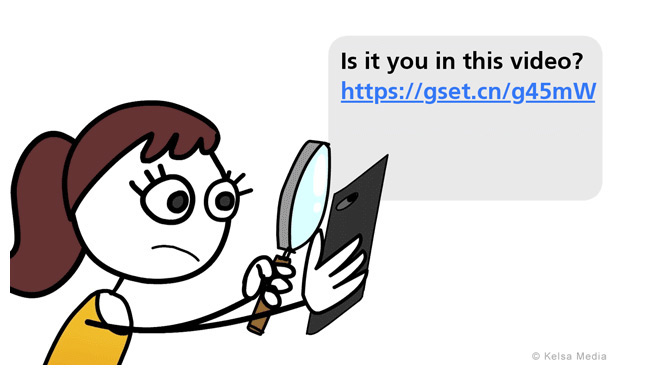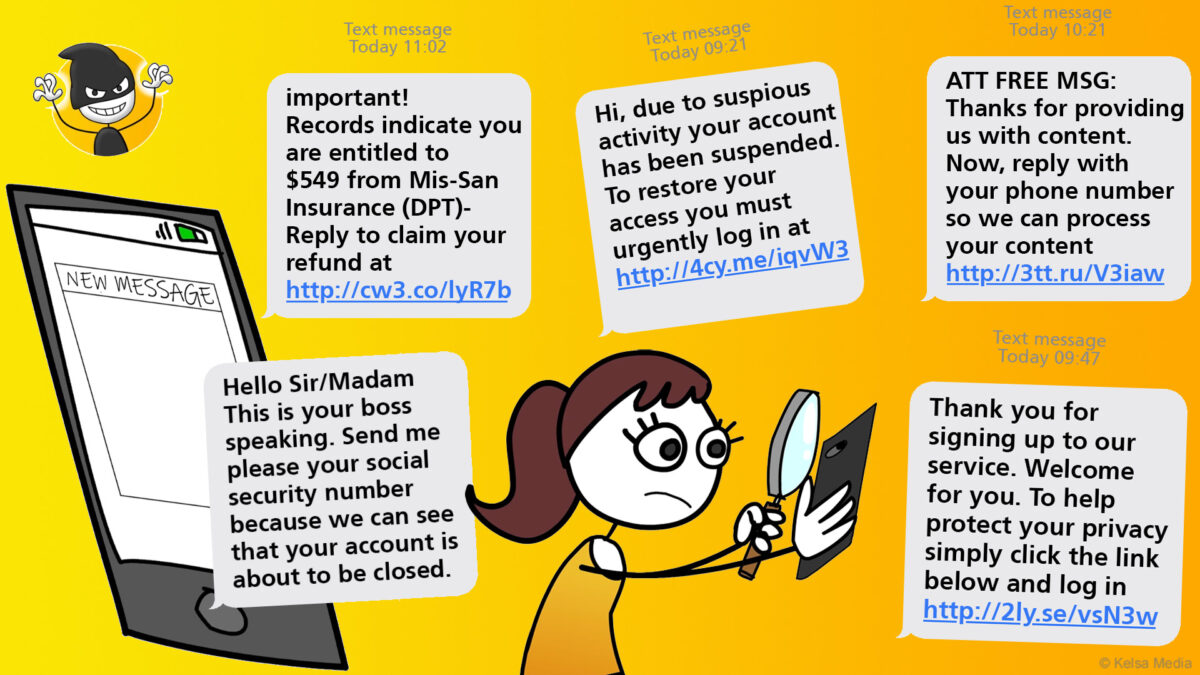Newsletter from Kelsa Media on 28 April 2022
Hackers ravage the mobiles

“Is it you in this video?”
A question such as “Is it you in this video?” is a typical question in a smishing-message on the mobile phone. And it would appear as if the message had been sent by a good friend.
“Which video? I better check that!”
The problem is that we much too easily forget about the cybersecurity rules because we are curious.
And if, on top of that, we are occupied with something at the time when we receive such a message, then things can go terribly wrong. The message could be coming fromcybercriminals, who know that the best time to trick us is when we are busy or not paying proper attention – for instance when we are out shopping or engaging with family and children.

In the midst of the hustle and bustle, we can easily be lured into clicking on a dangerous link, and this can be the start of a malicious ransomware attack that can end up paralysing the workplace’s IT systems.
We must protect ourselves against this – and in the e-learning courses from Humour against hacking we are now ready with a new elearning course about smishing:


Avoid the hackers’ traps
A good rule of thumb is to only click on links and open files if you are absolutely sure they were sent by someone you trust and have been in personal contact with about it. And even then, you need to be careful, because that person may have had their account hacked.
You must also be very careful when filling in your data, for example in connection with good offers or competitions.
And always consider an extra time whether the data you pass on could be misused. This is the kind of consideration which is easily forgotten if you are very busy or a little stressed.

The beginning of your awareness campaign?
Using the new smishing course to raise awareness among employees could open up the opportunity for you to engage with a longer awareness campaign about cybersecurity in your organisation .
Humour against hacking is a simple and easy-to-understand awareness campaign with a wide range of e-learning courses on everything from phishing to personal data and GDPR.
With a twist of humour and a glimpse in the eye Humour against hacking can help your organisation create a resilient ‘human defense shield’ against the dangerous hacker-attacks.
→ Contact us, if you would like to know more about our online courses about
cybersecurity and personal data. Send an email to: info@kelsa.dk

What do hackers achieve with smishing?
Why do they do it? What do the hackers hope to gain from their smishing messages?
They do this because they want to gather as much information as possible about you as an individual, but also about you as a representative of your organisation. Because in that way, they can gain insight into what’s really important to them – which is money.

The hackers try to steal or cheat themselves to gain access to confidential data. It can be all kinds of data:
- With codes for a bank account, they can empty the account
- With health information, they can reveal deeply private matters
- With financial data from companies, hackers can influence stock prices
The threat of publishing sensitive data in itself can be a lucrative affair for cybercriminals and hackers.
→ More about smishing on our Danish home page

Phishing-test can show whether you are an easy target
Is your organisation resistant to hacker attacks? You can find out with a simulated phishing test.
We regularly perform simulated phishing tests for companies and organisations, large and small, and both public and private.
It turns out the level of employee awareness is strikingly different from one organisation to another. In some organisations, only 5 percent of employees click on the “dangerous” link in the simulated phishing email, while in other organisations it is over 20 percent. In one organisation we tested, more than a third of the employees clicked on the link in the email and then went on to give away their password credentials on a fake webpage.
We recommend simulated phishing test – in the name of cybersecurity.
Call us and get a good offer for a simulated phishing test. Or click here:
ContactContact us for an online guided tour in our awareness universe. We are alwas open to an informal chat with no strings attached. Let us show you our material and explain why it works so well! 🙂 Kind regards Kind regards Lis Kelså – producer and director Kelsa Media ApS | lis@kelsa.dk Tel: +45 2261 0041 CVR: DK41453249 |
Copyright © 2022 Kelsa Media, All rights reserved.

